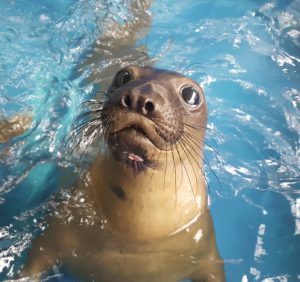Seal Survives Shark Strike
Northern Elephant Seal Receives Care

After nearly two months of rehabilitation, this Northern elephant seal is ready for release! The injury to the chin caused by a cookiecutter shark has caused permanent scarring to the animal’s chin, but healing progressed well and he should have no lingering effects from the injury. Photo by Jeff Hall
By Marine Program Manager, Jeff Hal
Cookiecutter sharks sound like they’d be something really cute. I draw images in my head of a rotund little shark, slowly marauding through the ocean with googly eyes, looking for cookie prey. The reality is something not as lovable. Cookiecutter sharks have round mouths ringed with teeth. They will prey upon nearly any animal in the sea by latching onto skin of the animal and spinning, using their sharp teeth to remove a round piece of flesh. The wound looks like it was made by a cookie cutter, hence the shark’s uniquely cute-sounding name.

This Northern elephant seal was rescued by CWC’s Marine Department at La Costa Beach in Malibu with severe injuries to his chin and right side. Photo by Lorraine Barbosa
In April of this year, CWC’s Marine Department rescued an underweight Northern elephant seal pup from La Costa Beach in Malibu that was suffering from two cookiecutter shark wounds. One was on the animal’s right side; the other was under his chin. Both were significant, but the chin wound posed the greatest danger as jaw bone was exposed.
Marine Department staff and veterinarians worked daily to ensure the wound was kept clean, not an easy task for an animal that lies on his belly. With constant cleaning (such as extra scrubbing of the enclosure flooring and letting the seal rest his head on clean towels), a course of antibiotics, numerous surgeries to debride the wound, and a few hundred pounds of fish, this Northern elephant seal was prepared to be returned to the wild! On June 8, a team of CWC staff and volunteers helped carry his 154 pounds of blubber to the beach for release at Leo Carillo State Beach in Malibu! Returning animals to the wild is always the most rewarding part of working and volunteering at CWC.
Saving an animal with cookiecutter shark wounds is just one of many examples of the hundreds of animals CWC’s Marine Department responds to each year. To put it in perspective, in 2015, CWC responded to 568 reports of marine mammals stranded on the beach and rescued a total of 325 animals. Of the 325 animals rescued, 138 were brought to CWC for rehabilitative care. If a rescued animal is not taken to CWC’s marine mammal rehabilitation facility it is brought to other regional facilities such as the Marine Mammal Care Center at Fort MacArthur in San Pedro.
Luckily for marine mammals in the area, 2016 has been a somewhat slower season, but the Marine Department has still been responding to high numbers of stranded marine mammals. In the first six months of 2016, CWC has responded to 331 reports of stranded marine mammals and rescued 208 of those animals. Of the 208 rescued animals, 52 were brought to CWC for rehabilitative care. Typically, CWC’s Marine Department sees an increase in rescues during the summer months because of increased human activity at the beaches. There is also an increase in rescues of California sea lion pups which are born between May and July. If something happens to a pup’s mother, or if the animal is weaned too early, they will need an organization like California Wildlife Center to help them along.
Whether it is caring for a California sea lion that was entangled in fish netting or rehabilitating a Northern elephant seal with textbook cookiecutter shark wounds, CWC’s Marine Dept. staff and volunteers are doing our part to return sick and injured wildlife back to nature!
